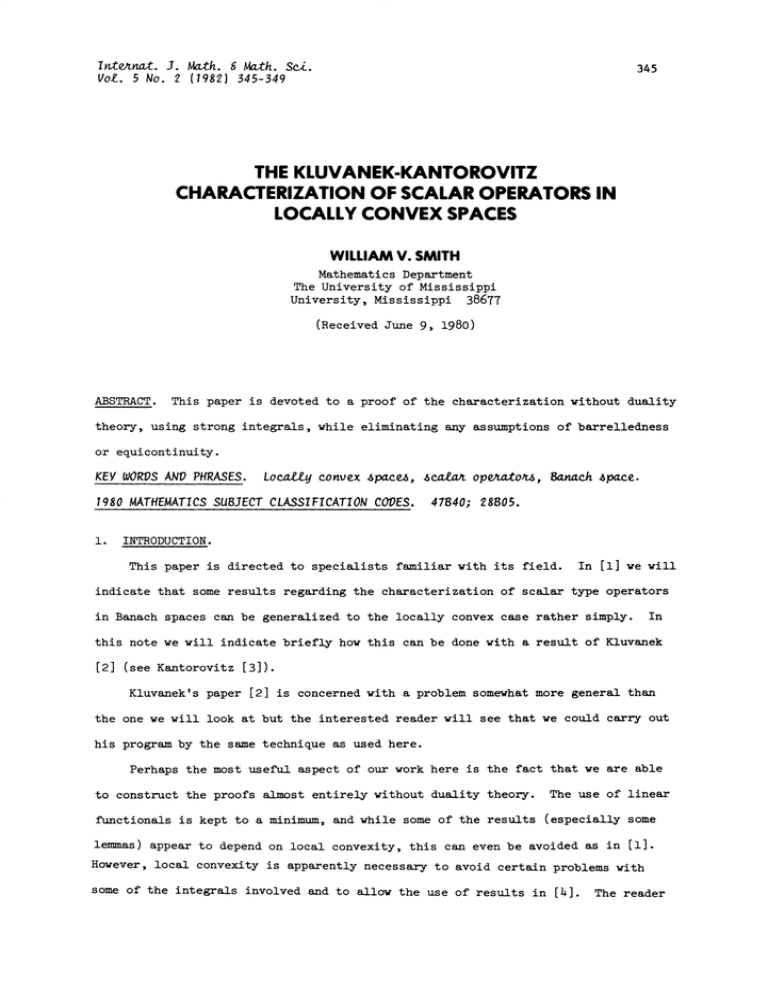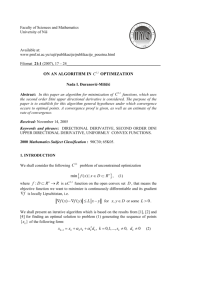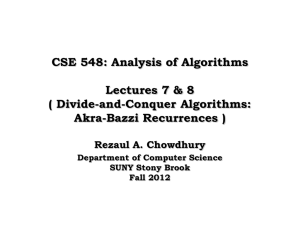THE KLUVANEK-KANTOROVITZ CHARACTERIZATION OF SCALAR OPERATORS IN LOCALLY SPACES
advertisement

I ntnat. J. Math. & Math. Sci.
Vol. 5 No. 2 (1982) 345-349
345
THE KLUVANEK-KANTOROVITZ
CHARACTERIZATION OF SCALAR OPERATORS IN
LOCALLY CONVEX SPACES
WILLIAM V. SMITH
Mathematics Department
The University of Mississippi
University, Mississippi 38677
(Received June 9, 1980)
ABSTRACT.
This paper is devoted to a proof of the characterization without duality
theory, using strong integrals, while eliminating any assumptions of barrelledness
or equicontinuity.
KEY WORDS AND PHRASES.
Locally convex space,
1980 MATHEMATICS SUBJECT CLASSIFICATION CODES.
1.
s opors,
Banach
ace.
47B40; 28B05.
INTRODUCTION.
This paper is directed to specialists familiar with its field.
In
Ill
we will
indicate that some results regarding the characterization of scalar type operators
in Banach spaces can be generalized to the locally convex case rather simply.
In
this note we will indicate briefly how this can be done with a result of Kluvanek
[2] (see
Kantorovitz
[3]).
Kluvanek’s paper [2] is concerned with a problem somewhat more general than
the one we will look at but the interested reader will see that we could carry out
his program by the same technique as used here.
Perhaps the most useful aspect of our work here is the fact that we are able
to construct the proofs almost entirely without duality theory.
functionals is kept to a minimum, and while some of the results
The use of linear
(especially some
lemmas) appear to depend on local convexity, this can even be avoided as in [1].
However, local convexity is apparently necessary to avoid certain problems with
some of the integrals involved and to allow the use of results in [h].
The reader
346
W.V. SMITH
will also note that the spaces involved are not assumed to be barrelled nor the
This is an improvement over previous work in the
spectral measures equicontinuous.
area.
2.
NOTATION AND PRELIMINARIES.
L(X)
will be the continuous endomorphisms of a quasicomplete separated locally
convex topological vector space X; we assume
L(X)
is quasicomplete for simple con-
S will be a locally compact Hausdorff space and
vergence.
C0(S)
will be the con-
llfl[ will
tinuous complex valued functions on S which vanish at infinity,
will den’ote the Fourier transform of a function f on
the supremum norm of f, and
’
denote
the real line.
LEMMA 2.1.
L(X)
Suppose P: B
Let B be the Borel subsets of S.
countably additive set function and D is a dense subalgebra of
C0(S).
is a regular
If S is a
metric space and
(f f)(f
fgdP
D, then P is multiplicative (i.e., P(E
for f, g c
PROOF OF LEMM 2.1.
IU E2):P(EI)P(E2)--P(E2)P(EI)).
The proof may be done using the fact that P has bounded
semivariation and by considering the argument in
LEMM 2.2.
gd2)
(2.5) of i].
Let D be as in Lemma 2.1. and consider
$
D
X.
Suppose
is relatively weakly compact in X.
Then
$
is a continuous
operator and there is a unique X-valued countably
additive regular set function m such that
$(f)
Conversely, if such an m exists, then
for f e D.
PROOF OF LEMMA 2.2.
Theorem
h
fdm
See Lewis
K5S,
rith the proof of Lemma 2 in
REMARK.
The fact that
$
(*)
is relatively weakly compact.
page 16h; or, when
16S
appears, use
K2S.
is continuous on all of
C0(S)
can be inferred from
the fact that in a locally convex space weakly bounded sets are bounded and from
the fact that bounded linear maps from an F-space to a topological vector space are
c ont i nuous.
_
SCALAR OPERATORS IN LOCALLY CONVEX SPACES
3
CKARACTERI ZAT ION.
Let T e L(X).
THEOREM 3.1.
is a relatively weally
T is scalar with real spectrum if and only if
{F f(s)eiSTxds
(+)
347
.
IIII <_ i,
f
LI(-,)}
coml:.ct subset of X for x e X.
PROOF OF TttNOREM 3.1.
The map
pact and, therefore, by Lemma 2.2,
f )eSTds
’ f(s)eiSTxds
I
f(s
+
x’ e X’ the continuous dual of X then recalling that
f(s) (eiSTx ,x’ )ds
is continuous and weakly com-
dux
la
x
for each x e X.
If
is bounded
f d(Ux,X’
I
f(t)e-iStdt
f(t) f
e
-ist
d( x (s),x’)
d(lax(S),x’)dt
_/ e( f -s a(Ux(S, x,
and, therefore,
eitTx ,x’
by continuity of e
itT
x in t.
Since e
e
Define
Ux(E).
P(E)(x)
the strong operator
[
f(x-y)g(y)dy,
[ e-iSt (x(S) ,x’)
itT
Then P is
topology).
x
bounded,
is
./ e- ist dx(S)
L(X) valued countably
LI(II).
g e
additive and regular (in
*g(x)
then
f(t)eitTdt / g(u)eiUTxdu
Therefore since f.g
fg,
LI(IR I)
Since
plicative and setting t
0 in
i
(Px (E)
P(E)x)
f dPx
f 9dPx f
for all f
(B.l)
Now it is easy to see that if
[ f*g(s)eiStxds
for all f, g
ist
is dense in
(3.1) gives P(I I)
C0(]RI),
by Lemma 2.2, P is multi-
I the identity in L(X).
Hence
P is a spectral measure.
Notice
of
[7] we
e
ist
have
it
i
s as t
0 and using Proposition
(the proof of (5.)
is what is
(h.1)
required)
x
and Proposition
(5.h)
348
W.V. SMITH
-
for all x in a dense subset of X and if 8
P(6 n )Tx
then it is clear that
x by continuity of T and since
/-Tx for all
-Tx we have
dPP(Sn)X
lim
n-
[-n,n],
n
Conversely, if Tx
kdPx,
kdP
then e
e-iSdp
x
[2].
LI(I),
a
f(s)eiSTxds
isT
x
exists as a
and this implies
f(s)e-iSdp() xds
f(s)eiSTxds
/
and one can show that e
x
Furthermore,
[hi for every f
Pettis integral by Thomas
is closed and
x
Therefore, T is scalar.
Tx for all x.
x
isT
is continuous in s and bounded as in
kdP
TP(6 n )x
or
( f(s)eiSTxds
f(s)e-iSdpX ()ds
(
x’)
x’)
f(s)e-iSd(Px(),x’)ds
fCs)e-iSdsd(P(X)x,X’)
and so
f(s) eiSTxds
pact by Lemma 2.2.
()dPx()
and, therefore, (+) is relatively weakly com-
This completes the proof.
A very well-known result of Bochner is:
THEOREM 3.2.
If
(t)
< t <
is continuous for
_< K
holds for all finite complex sequences {c
exists a complex measure
sup
zaR r 1
r 1
r
and has the property that
Cr e
and rational sequences
I eitZd(z), IIII
r
then there
< K
Using this result and the methods of 3.1. above and Lemma
omit the
{t
s.t.
$(t)
follow,ing (we
r
7 of [3], we obtain the
proof).
Suppose the operator T e L(X) satisfies the following where
THEOREM 3.3.
x a A a bounded subset of X and x’ a A’ an equicontinuous subset of X’
-2it T
n
sup
xaA
C
r 1
r
xte
x’
Ir
x
-2it t
< M sup
taR r 1
c e
r
Ir
Suppose in addition that X is weakly sequentially complete.
scalar operator with real spectrum.
Then T is a
349
SCALAR OPERATORS IN LOCALLY CONVEX SPACES
HEFEHENCES
Spectral Measures in Topological Algebras and Scalar Type Operators II (to appear), Pe___r. Math. Hung.
i.
SMITH, W. V.
2.
KLUVANEK, I.
Characterization of Fourier-StieltJes Transforms of Vector and
Operator Valued Measures, Czechoslovak Math. J. 17 (92), (1967), pp. 261-
2"1’7.
3.
KANTOROVIT’Z,
S. On the Characterization of Spectral Operators, Transactions
American Mathematical Society ii__i (196h), pp. 152-181.
o__f
THOMAS, G. E. F. Totally Summable Functions with Values in Locally Convex
Spaces, Measure Theory, Ober. (1975), Springer Lecture Notes, Berlin,
(96).
5.
LEWIS, D. R.
Integration with Respect to Vector
Measures, Pacifi_c J. Math.
3__B, pp. 157-165
6.
SMITH, W. V. and D. H. TUCKER Weak Integral Convergence Theorems and Weak
Compactness (to appear), Pacific J. Math.
SMITH, W. V. Spectral Measures in Topological Algebras and Scalar Type Operators I (to appear), Per. Math. Hung.








